Electrocoagulation Combined with Synthetic Zeolite—Does the Size of Zeolite Particles Matter?
Abstract
:1. Introduction
2. Materials and Methods
3. Results and Discussion
3.1. Analysis of the Physicochemical Parameters of the ECZ Process
3.1.1. pH Change
3.1.2. Temperature Change
3.1.3. COD Decrease
3.1.4. Turbidity Decrease
3.1.5. Settling Test
3.1.6. Electrode Consumption
3.1.7. Stability of ECZ Experiments
3.2. Microscopic Electrode Surface Analysis
3.3. Zeolite and Electro-Generated Sludge Analysis
3.4. Taguchi Optimization
3.5. Energy and Electrode Consumption during ECZ Process
4. Conclusions
Author Contributions
Funding
Data Availability Statement
Acknowledgments
Conflicts of Interest
References
- Król, M. Natural vs. Synthetic Zeolites. Crystals 2020, 10, 622. [Google Scholar] [CrossRef]
- Hardi, G.W.; Maras, M.A.J.; Riva, Y.R.; Rahman, S.F. A Review of Natural Zeolites and Their Applications: Environmental and Industrial Perspectives. Int. J. Appl. Eng. Res. 2020, 15, 730–734. Available online: https://www.ripublication.com/ijaer20/ijaerv15n7_16.pdf (accessed on 15 July 2023).
- Velarde, L.; Nabavi, M.S.; Escalera, E.; Antti, M.-L.; Akhtar, F. Adsorption of heavy metals on natural zeolites: A review. Chemosphere 2023, 328, 138508. [Google Scholar] [CrossRef] [PubMed]
- Kuldeyev, E.; Seitzhanova, M.; Tanirbergenova, S.; Tazhu, K.; Doszhanov, E.; Mansurov, Z.; Azat, S.; Nurlybaev, R.; Berndtsson, R. Modifying Natural Zeolites to Improve Heavy Metal Adsorption. Water 2023, 15, 2215. [Google Scholar] [CrossRef]
- Yuna, Z. Review of the Natural, Modified, and Synthetic Zeolites for Heavy Metals Removal from Wastewater. Environ. Eng. Sci. 2016, 33, 443–454. [Google Scholar] [CrossRef]
- Guida, S.; Potter, C.; Jefferson, B.; Soares, A. Preparation and evaluation of zeolites for ammonium removal from municipal wastewater through ion exchange process. Sci. Rep. 2020, 10, 12426. [Google Scholar] [CrossRef]
- Jiménez-Reyes, M.; Almazán-Sánchez, P.T.; Solache-Ríos, M. Radioactive waste treatments by using zeolites. A short review. J. Environ. Radioact. 2021, 233, 106610. [Google Scholar] [CrossRef]
- Derbe, T.; Temesgen, S.; Bitew, M. A Short Review on Synthesis, Characterization, and Applications of Zeolites. Adv. Mater. Sci. Eng. 2021, 2021, 6637898. [Google Scholar] [CrossRef]
- Łach, M.; Grela, A.; Pławecka, K.; Guigou, M.D.; Mikuła, J.; Komar, N.; Bajda, T.; Korniejenko, K. Surface Modification of Synthetic Zeolites with Ca and HDTMA Compounds with Determination of Their Phytoavailability and Comparison of CEC and AEC Parameters. Materials 2022, 15, 4083. [Google Scholar] [CrossRef]
- Valdés, H.; Riquelme, A.L.; Solar, V.A.; Azzolina-Jury, F.; Thibault-Starzyk, F. Removal of chlorinated volatile organic compounds onto natural and Cu-modified zeolite: The role of chemical surface characteristics in the adsorption mechanism. Sep. Purif. Technol. 2021, 258, 118080. [Google Scholar] [CrossRef]
- Pavlinović, A.; Novaković, M.; Nuić, I. Removal of carbendazim from aqueous solutions by adsorption on different types of zeolite. ST Open 2021, 2, e2021.1906.14. [Google Scholar] [CrossRef]
- Ugrina, M.; Vukojević Medvidović, N.; Daković, A. Characterization and environmental application of iron modified zeolite from the Zlatokop deposit. Desalin. Water Treat. 2015, 53, 3557–3569. [Google Scholar] [CrossRef]
- de Magalhães, L.F.; da Silva, G.R.; Peres, A.E.C. Zeolite Application in Wastewater Treatment. Adsorpt. Sci. Technol. 2022, 2022, 4544104. [Google Scholar] [CrossRef]
- Castro, C.J.; Shyu, H.Y.; Xaba, L.; Bair, R.; Yeh, D.H. Performance and onsite regeneration of natural zeolite for ammonium removal in a field-scale non-sewered sanitation system. Sci. Total Environ. 2021, 776, 145938. [Google Scholar] [CrossRef] [PubMed]
- Vukojević Medvidović, N.; Svilović, S. Cyclic zinc capture and zeolite regeneration using a column method, mass transfer analysis of multi regenerated bed. J. Environ. Health Sci. Eng. 2023. [Google Scholar] [CrossRef]
- Vukojević Medvidović, N.; Perić, J.; Trgo, M. Column performance in lead removal from aqueous solutions by fixed bed of natural zeolite–clinoptilolite. Sep. Purif. Technol. 2006, 49, 237–244. [Google Scholar] [CrossRef]
- Margeta, K.; Farkaš, A. Introductory Chapter: Zeolites—From Discovery to New Applications on the Global Market. In Zeolites—New Challenges; Margeta, K., Farkaš, A., Eds.; IntechOpen: London, UK, 2020. [Google Scholar] [CrossRef]
- Khaleque, A.; Alam, M.M.; Hoque, M.; Mondal, S.; Haider, J.B.; Xu, B.; Johir, M.A.H.; Karmakar, A.K.; Zhou, J.L.; Ahmed, M.B.; et al. Zeolite synthesis from low-cost materials and environmental applications: A review. Environ. Adv. 2020, 2, 100019. [Google Scholar] [CrossRef]
- Salahudeen, N.A. Review on Zeolite: Application, Synthesis and Effect of Synthesis Parameters on Product Properties. Chem. Afr. 2022, 5, 1889–1906. [Google Scholar] [CrossRef]
- Saravanan, A.; Senthil Kumar, P.; Jeevanantham, S.; Karishma, S.; Tajsabreen, B.; Yaashikaa, P.R.; Reshma, B. Effective water/wastewater treatment methodologies for toxic pollutants removal: Processes and applications towards sustainable development. Chemosphere 2021, 280, 130595. [Google Scholar] [CrossRef]
- Mohammad, A.W.; Ang, W.L. (Eds.) Integrated and Hybrid Process Technology for Water and Wastewater Treatment, 1st ed.; Elsevir: Amsterdam, The Netherland, 2021; Available online: https://books.google.hr/books?id=ViMZEAAAQBAJ&pg=PR3&hl=hr&source=gbs_selected_pages&cad=2#v=onepage&q&f=false (accessed on 7 July 2023).
- Das, P.P.; Sharma, M.; Purkait, M.K. Recent progress on electrocoagulation process for wastewater treatment: A review. Sep. Purif. Technol. 2022, 292, 121058. [Google Scholar] [CrossRef]
- Tawalbeh, M.; Al-Shannag, M.; Al-Anber, Z.; Bani-Melheme, K. Combined electrocoagulation processes as a novel approach for enhanced pollutants removal: A state-of-the-art review. Sci. Total Environ. 2020, 744, 140806. [Google Scholar] [CrossRef]
- Tegladza, I.D.; Xu, Q.; Xu, K.; Lv, G.; Lu, J. Electrocoagulation processes: A general review about role of electro-generated floc in pollutant removal. Process Saf. Environ. Prot. 2021, 146, 169–189. [Google Scholar] [CrossRef]
- Moussa, D.T.; El-Naas, M.H.; Nasser, M.; Al-Marri, M.J. A comprehensive review of electrocoagulation for water treatment: Potentials and challenges. J. Environ. Manag. 2017, 186, 24–41. [Google Scholar] [CrossRef]
- Bharath, M.; Krishna, B.M.; Kumar, B.M. A review of electrocoagulation process for wastewater treatment. Int. J. Chem. Tech. Res. 2018, 11, 289–302. Available online: https://sphinxsai.com/2018/ch_vol11_no3/3/(289-302)V11N03CT.pdf (accessed on 5 June 2023).
- Tahreen, A.; Jami, M.S.; Ali, F. Role of electrocoagulation in wastewater treatment: A developmental review. J. Water Process Eng. 2020, 37, 101440. [Google Scholar] [CrossRef]
- Mousazadeh, M.; Niaragh, E.K.; Usman, M.; Khan, S.U.; Sandoval, M.A.; Al-Qodah, Z.; Khalid, Z.B.; Gilhotra, V.; Emamjomeh, M.M. A critical review of state-of-the-art electrocoagulation technique applied to COD-rich industrial wastewaters. Environ. Sci. Pollut. Res. 2021, 28, 43143–43172. [Google Scholar] [CrossRef]
- Simonič, M.; Čurlin, M.; Fras Zemljič, L. Analysis of electrocoagulation process efficiency of compost leachate with the first order kinetic model. Holist. Approach Environ. 2020, 10, 35–40. Available online: https://hrcak.srce.hr/file/346950 (accessed on 7 July 2023). [CrossRef]
- Hamid, M.A.A.; Aziz, H.A.; Yusoff, M.S.; Abdul Rezan, S. Clinoptilolite augmented electrocoagulation process for the reduction of high-strength ammonia and color from stabilized landfill leachate. Water Environ. Res. 2020, 93, 596–607. [Google Scholar] [CrossRef]
- Hamid, M.A.A.; Aziz, H.A.; Yusoff, M.S.; Abdul Rezan, S. Optimization and analysis of zeolite augmented electrocoagulation process in the reduction of high-strength ammonia in saline landfill leachate. Water 2020, 12, 247. [Google Scholar] [CrossRef]
- Hamid, M.A.A.; Aziz, H.A.; Yusoff, M.S.; Rezan, S.A.A. Continuous clinoptilolite augmented SBR-electrocoagulation process to remove concentrated ammonia and colour in landfill leachate. Environ. Technol. Innov. 2021, 23, 101575. [Google Scholar] [CrossRef]
- Sutanto; Rohadi, N. Effect of Addition of Zeolite and Sodium Chloride on Changes in Bacterial Content and Turbidity in Industrial Wastewater Treatment into Drinking Water using Electrocoagulation Process. In Proceedings of the 8th Annual Southeast Asian International Seminar (ASAIS 2019), Jakarta, Indonesia, 7–8 November 2019; pp. 67–73. [Google Scholar] [CrossRef]
- Alenezi, A.K.; Hasan, H.A.; Hashim, K.S.; Amoako-Attah, J.; Gkantou, M.; Muradov, M.; Kot, P.; Abdulhadi, B. Zeolite-assisted electrocoagulation for remediation of phosphate from calcium-phosphate solution. IOP Conf. Ser. Mater. Sci. Eng. 2020, 888, 012031. [Google Scholar] [CrossRef]
- Zolfaghari, M.; Magdouli, S.; Tanabene, R.; Komtchou, S.P.; Martial, R.; Saffar, T. Pragmatic strategy for the removal of ammonia from gold mine effluents using a combination of electro-coagulation and zeolite cation exchange processes: A staged approach. J. Water Process Eng. 2020, 37, 101512. [Google Scholar] [CrossRef]
- Vrsalović, L.; Vukojević Medvidović, N.; Svilović, S.; Pavlinović, A. Taguchi method in the optimization of municipal wastewater treatment by electrocoagulation integrated with zeolite. Energy Rep. 2023, 9, 59–76. [Google Scholar] [CrossRef]
- Svilović, S.; Vukojević Medvidović, N.; Vrsalović, L.; Kulić, A. Combining natural zeolite and electrocoagulation with different electrode materials—Electrode surface analysis and Taguchi optimization. Appl. Surf. Sci. Adv. 2022, 12, 100330. [Google Scholar] [CrossRef]
- Vukojević Medvidović, N.; Vrsalović, L.; Ugrina, T.; Jukić, I. Electrocoagulation augmented with natural zeolite—The new hybrid process for treatment of leachate from composting of biowaste. In Proccedings of the 19th International Foundrymen conference: Humans—Valuable Resource for Foundry Industry Development, Split, Croatia, 16–18 June 2021; Dolić, N., Zovko Brodarac, Z., Brajčinović, S., Eds.; University of Zagreb, Faculty of Metallurgy: Zagreb, Croatia, 2021; pp. 489–498. Available online: https://ifc.simet.hr/?page_id=2518 (accessed on 11 July 2023).
- Vukojević Medvidović, N.; Vrsalović, L.; Svilović, S.; Bobanović, A. Electrocoagulation vs. Integrate Electrocoagulation-Natural Zeolite for Treatment of Biowaste Compost Leachate—Whether the Optimum Is Truly Optimal. Minerals 2022, 12, 442. [Google Scholar] [CrossRef]
- Svilović, S.; Mužek, M.N.; Vučenović, P.; Nuić, I. Taguchi design of optimum process parameters for sorption of copper ions using different sorbents. Water Sci. Technol. 2019, 80, 98–108. [Google Scholar] [CrossRef]
- Svilović, S.; Rušić, D.; Stipišić, R.; Kuzmanić, N. Process optimization for copper sorption onto synthetic zeolite NaX. Bulg. Chem. Commun. 2020, 52, 189–196. [Google Scholar] [CrossRef]
- Vukojević Medvidović, N.; Vrsalović, L.; Svilović, S.; Bilušić, A.; Jozić, D. Electrocoagulation treatment of compost leachate using aluminium alloy, carbon steel and zinc anode. Appl. Surf. Sci. Adv. 2023, 15, 100404. [Google Scholar] [CrossRef]
- Apaydina, Ö.; Ozkan, E. Landfill leachate treatment with electrocoagulation: Optimization by using Taguchi method. Desalin. Water Treat. 2020, 173, 65–76. [Google Scholar] [CrossRef]
- Deghles, A.; Kurt, U. Treatment of raw tannery wastewater by electrocoagulation technique: Optimization of effective parameters using Taguchi method. Desalin. Water Treat. 2016, 57, 14798–14809. [Google Scholar] [CrossRef]
- Eaton, A.D.; Clesceri, L.S.; Rice, E.W.; Greenberg, A.E.; Franson, M.A.H. (Eds.) Standard Methods for the Examination of Water and Wastewater, 21st ed.; American Public Health Association (APHA): Washington, DC, USA; American Water Works Association (AWWA): Washington, DC, USA; Water Environment Federation (WEF): Washington, DC, USA, 2005. [Google Scholar]
- Safwat, S.M. Treatment of real printing wastewater using electrocoagulation process with titanium and zinc electrodes. J. Water Process Eng. 2020, 34, 101137. [Google Scholar] [CrossRef]
- Croatian Regulation on Emission Limits Values in Wastewater, NN 26/2020. (In Croatian). Available online: https://narodne-novine.nn.hr/clanci/sluzbeni/2020_03_26_622.html (accessed on 11 July 2023).
- Smoczyńskia, L.; Kalinowskia, S.; Ratnaweerab, H.; Kosobuckaa, M.; Trifescua, M.; Pieczulis-Smoczyńska, K. Electrocoagulation of municipal wastewater—A pilot-scale test. Desalin. Water Treat. 2017, 72, 162–168. [Google Scholar] [CrossRef]
- Vrsalović, L.; Vukojević Medvidović, N.; Svilović, S.; Šarić, J. Application of Different Metals as Electrode Material in Compost Leachate Treament. Kem. Ind. 2023, 72, 297–304. [Google Scholar] [CrossRef]
- Davis, J.R. Corrosion Understanding the Basic; ASM International: Materials Park, OH, USA, 2000. [Google Scholar]
- Vargel, C.; Jacques, M.; Schmidt, M.P. Corrosion of Aluminium; Elsevier: Amsterdam, The Netherlands, 2004. [Google Scholar]
- Tao, J. Surface Composition and Corrosion Behavior of an Al-Cu Alloy. Ph.D. Thesis, Université Pierre et Marie Curie—Paris VI, Paris, France, 2016. [Google Scholar]
- Chen, G.S.; Gao, M.; Wei, R.P. Microconstituent-induced pitting corrosion in aluminum alloy 2024-T3. Corrosion 1996, 52, 8–15. [Google Scholar] [CrossRef]
- Boag, A.; Taylor, R.J.; Muster, T.H.; Goodman, N.; McCulloch, D.; Ryan, C.; Rout, B.; Jamieson, D.; Hughes, A.E. Stable pit formation on AA2024-T3 in a NaCl environment. Corros. Sci. 2010, 52, 90–103. [Google Scholar] [CrossRef]
- Bewerskog, B.; Puigdomenech, I. Revised Pourbaix diagram for zinc at 25–300 °C. Corros. Sci. 1997, 39, 107–114. [Google Scholar] [CrossRef]
- Fajardo, A.S.; Rodrigues, R.F.; Martins, R.C.; Castro, L.M.; Quinta-Ferreira, R.M. Phenolic wastewater treatment by electrocoagulation process using Zn anode. Chem. Eng. J. 2015, 275, 331–341. [Google Scholar] [CrossRef]
- Krezel, A.; Maret, W. The biological inorganic chemistry of zinc ions. Arch. Biochem. Biophys. 2016, 611, 3–19. [Google Scholar] [CrossRef]
- Parga, J.R.; González, G.; Moreno, H.; Valenzuela, J.L. Thermodynamic studies of the strontium adsorption on iron species generated by electrocoagulation. Desalin. Water Treat. 2012, 37, 244–252. [Google Scholar] [CrossRef]
- Moreno, H.A.; Cocke, D.L.; Gomez, J.A.G.; Morkovsky, P.; Parga, J.R.; Peterson, E.; Garcia, C. Electrochemistry behind electrocoagulation using iron electrodes. ECS Trans. 2007, 6, 1–15. [Google Scholar] [CrossRef]
- Ingelson, M.; Yasri, N.; Roberts, E.P.L. Electrode passivation, faradaic efficiency, and performance enhancement strategies in electrocoagulation—A review. Water Res. 2020, 180, 116433. [Google Scholar] [CrossRef]
- Rakhmania; Kamyab, H.; Yuzir, M.A.; Abdullah, N.; Quan, L.M.; Riyadi, F.A.; Marzouki, R. Recent Applications of the Electrocoagulation Process on Agro-Based Industrial Wastewater: A Review. Sustainability 2022, 14, 1985. [Google Scholar] [CrossRef]
- Ammouli, T.; Paillaud, J.-L.; Nouali, H.; Stephan, R.; Hanf, M.-C.; Sonnet, P.; Deroche, I. Insights into Water Adsorption in Potassium-Exchanged X-type Faujasite Zeolite: Molecular Simulation and Experiment. J. Phy. Chem. C 2021, 125, 19405–19416. [Google Scholar] [CrossRef]
- Rouquerol, J.; Llewellyn, P.; Sing, K. 12-Adsorption by Clays, Pillared Clays, Zeolites and Aluminophosphates. In Adsorption by Powders and Porous Solids: Principles, Methodology and Applications, 2nd ed.; Rouquerol, F., Rouquerol, J., Sing, K.S.W., Llewellyn, P., Maurin, G., Eds.; Academic Press: Cambridge, MA, USA, 2014; pp. 467–527. [Google Scholar] [CrossRef]
- Castaldi, P.; Santona, L.; Enzo, S.; Melis, P. Sorption processes and XRD analysis of a natural zeolite exchanged with Pb2+, Cd2+ and Zn2+ cations. J. Hazard. Mater. 2008, 156, 428–434. [Google Scholar] [CrossRef] [PubMed]
- Barrera-Díaz, C.E.; Balderas-Hernández, P.; Bilyeu, B. Electrocoagulation: Fundamentals and Prospectives. In Electrochemical Water and Wastewater Treatment; Martínez-Huitle, C.A., Rodrigo, M.A., Scialdone, O., Eds.; Elsevier Inc.: Oxford, UK, 2018; pp. 61–76. [Google Scholar] [CrossRef]
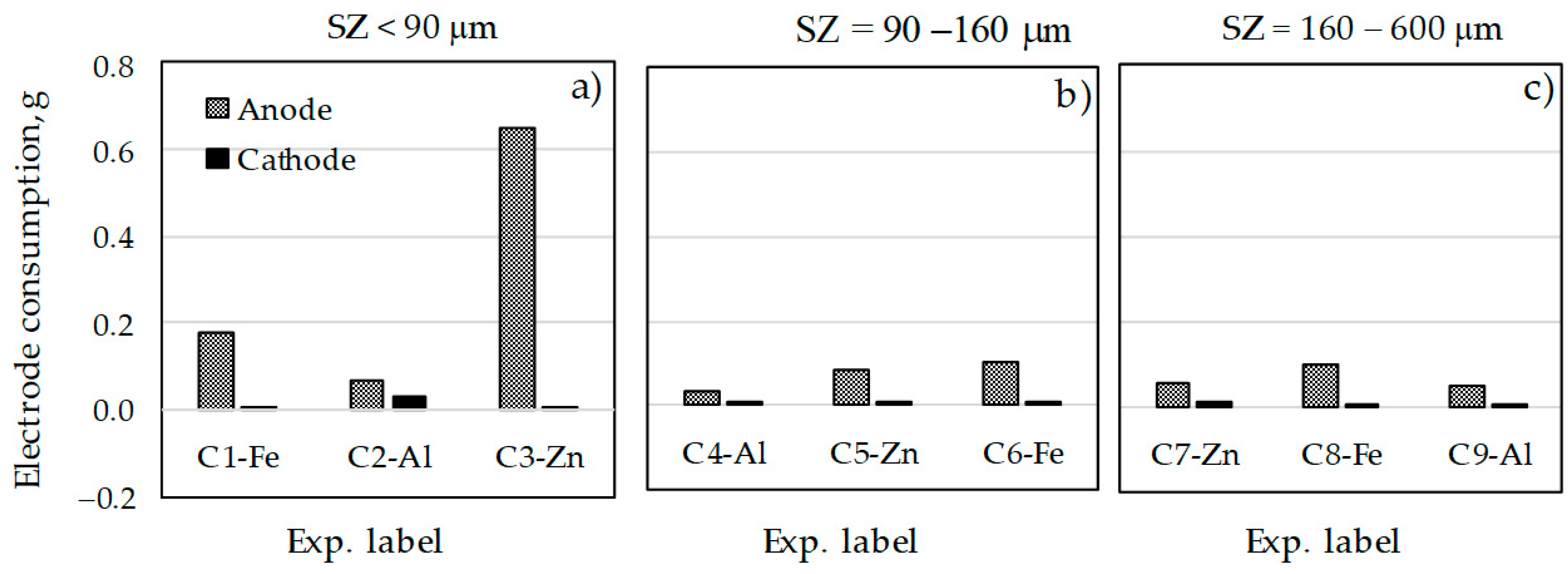



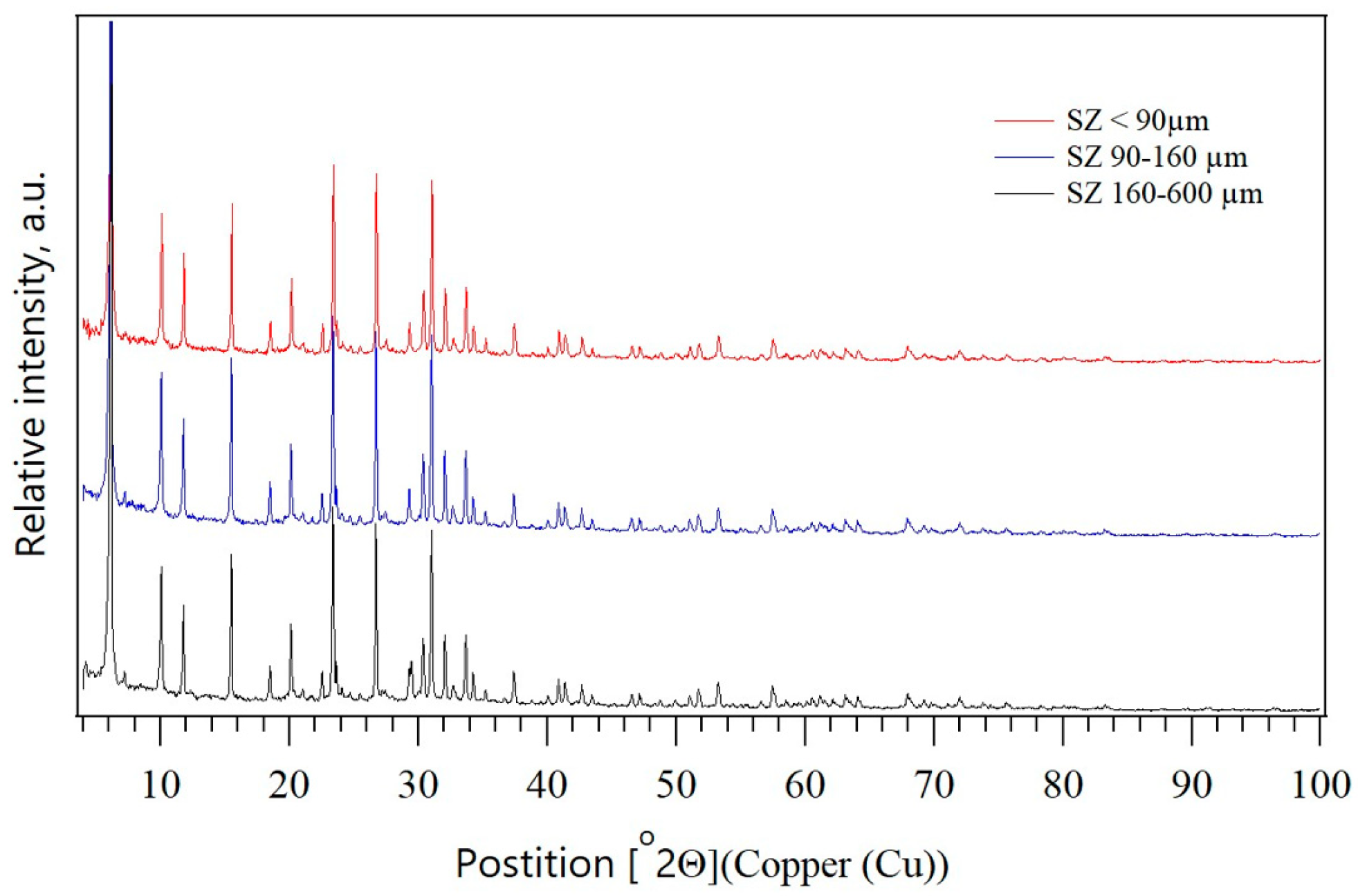
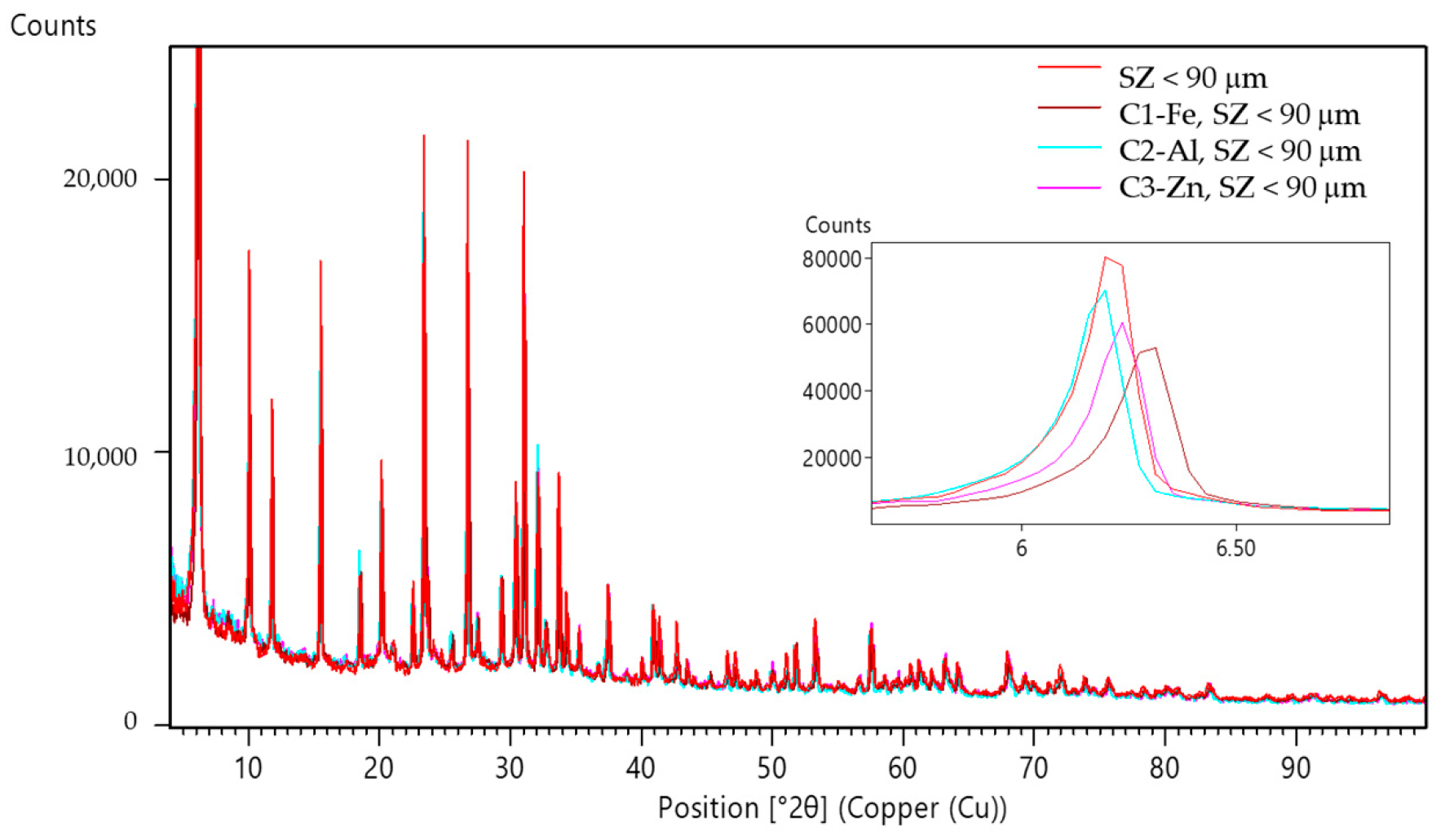
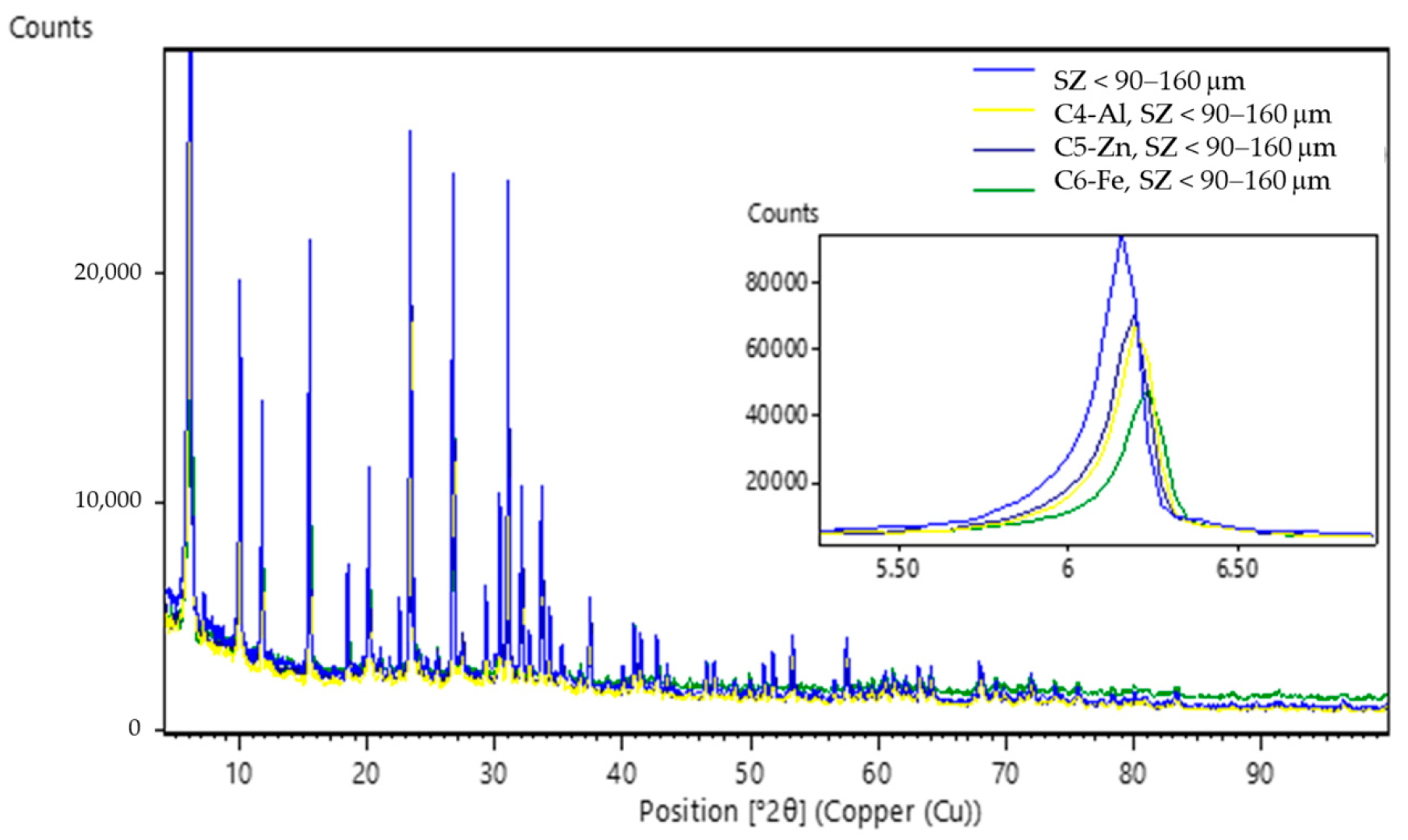


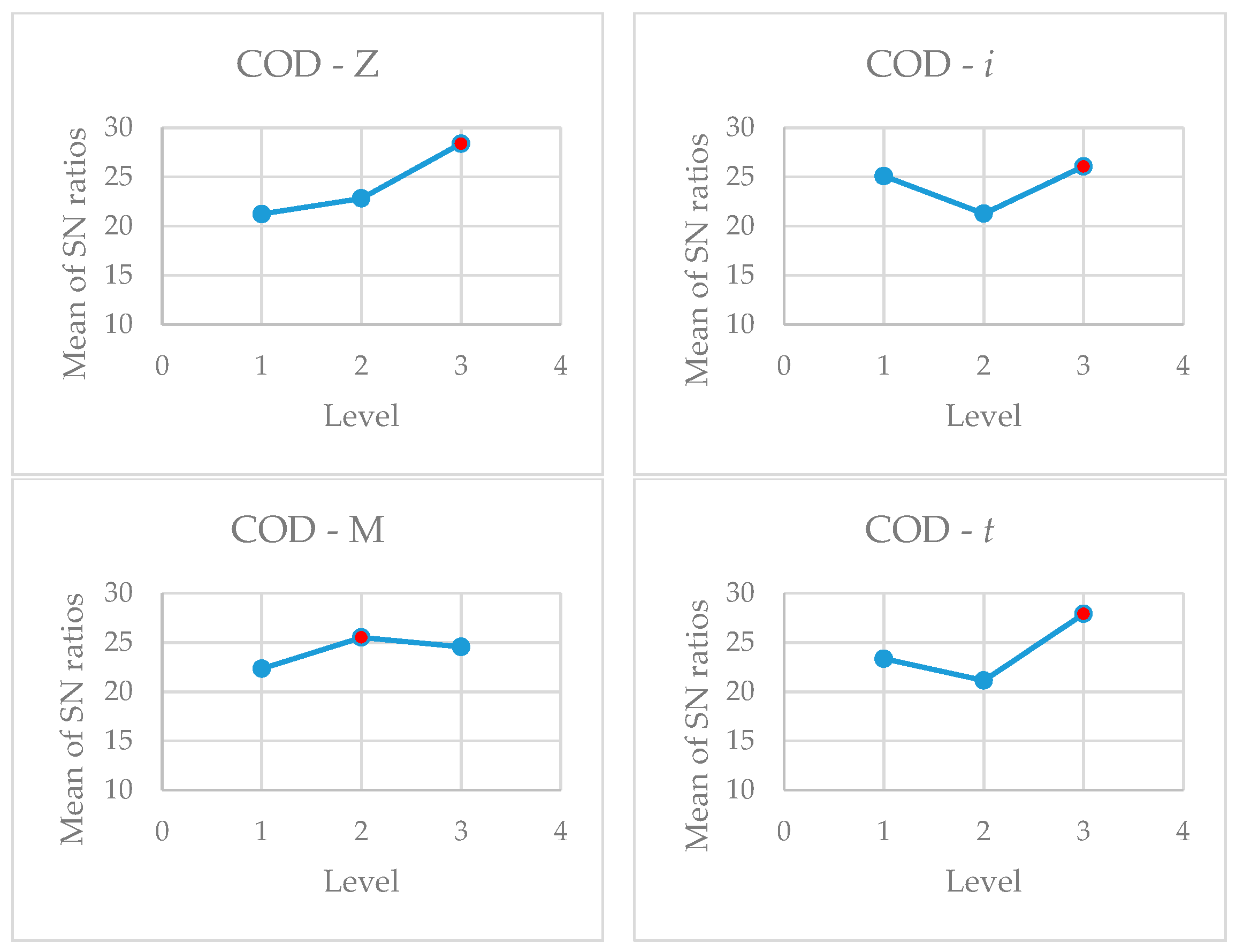
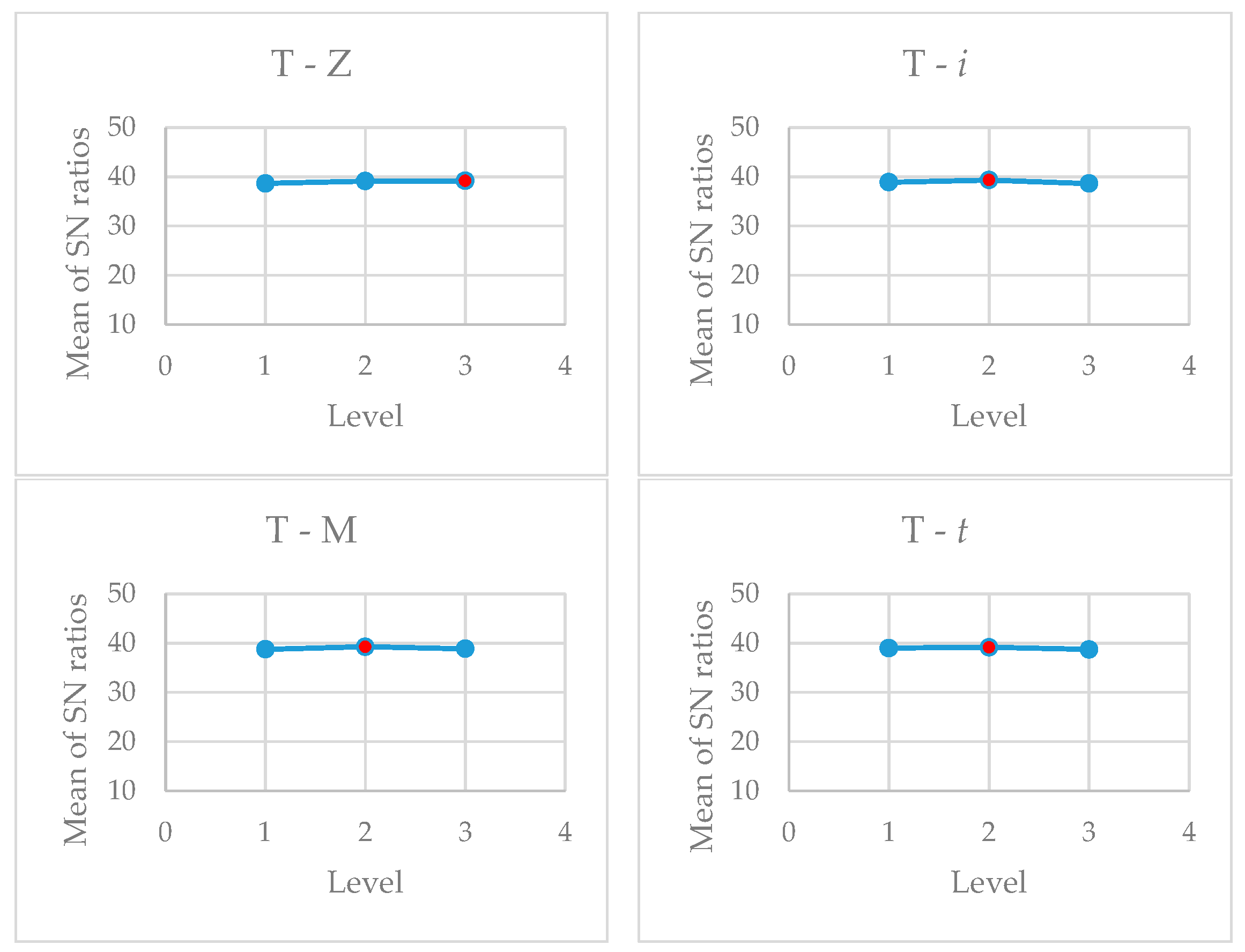
| Exp. Label | Experiments Condition during Each ECZ | Zeolite Particle Size [Z], μm | Current Density [i], A/cm2 | Electrode Material [M], - | Contact Time [t], min |
|---|---|---|---|---|---|
| C1 | ECZ-Fe, SZ (<90 μm), i = 0.003 A/cm2, 10 min | <90 (L1) | 0.003 (L1) | Fe (L1) | 10 (L1) |
| C2 | ECZ-Al, SZ (<90 μm), i = 0.009 A/cm2, 20 min | <90 | 0.009 (L2) | Al (L2) | 20 (L2) |
| C3 | ECZ-Zn, SZ (<90 µm), i = 0.018 A/cm2, 30 min | <90 | 0.018 (L3) | Zn (L3) | 30 (L3) |
| C4 | ECZ-Al, SZ (90–160 µm), i = 0.003 A/cm2, 30 min | 90–160 (L2) | 0.003 | Al | 30 |
| C5 | ECZ-Zn, SZ (90–160 µm), i = 0.009 A/cm2, 10 min | 90–160 | 0.009 | Zn | 10 |
| C6 | ECZ-Fe, SZ (90–160 µm), i = 0.018 A/cm2, 20 min | 90–160 | 0.018 | Fe | 20 |
| C7 | ECZ-Zn, SZ (160–600 µm), i = 0.003 A/cm2, 20 min | 160–600 (L3) | 0.003 | Zn | 20 |
| C8 | ECZ-Fe, SZ (160–600 µm), i = 0.009 A/cm2, 30 min | 160–600 | 0.009 | Fe | 30 |
| C9 | ECZ-Al, SZ (160–600 µm), i = 0.018 A/cm2, 10 min | 160–600 | 0.018 | Al | 10 |
| Exp. Label | Experiments Condition during Each ECZ | pHfin | Tfin, °C | COD Decrease, % | Turbidity Decrease, % |
|---|---|---|---|---|---|
| C1 | ECZ-Fe, SZ (<90 μm), i = 0.003 A/cm2, 10 min | 5.52 | 24.2 | 9.54 | 83.32 |
| C2 | ECZ-Al, SZ (<90 μm), i = 0.009 A/cm2, 20 min | 6.20 | 27.6 | 6.87 | 94.58 |
| C3 | ECZ-Zn, SZ (<90 µm), i = 0.018 A/cm2, 30 min | 8.56 | 35.7 | 23.28 | 79.47 |
| C4 | ECZ-Al, SZ (90–160 µm), i = 0.003 A/cm2, 30 min | 4.83 | 25.8 | 27.86 | 90.60 |
| C5 | ECZ-Zn, SZ (90–160 µm), i = 0.009 A/cm2, 10 min | 5.24 | 27.0 | 9.54 | 93.68 |
| C6 | ECZ-Fe, SZ (90–160 µm), i = 0.018 A/cm2, 20 min | 5.25 | 27.1 | 9.92 | 86.45 |
| C7 | ECZ-Zn, SZ (160–600 µm), i = 0.003 A/cm2, 20 min | 4.81 | 26.0 | 21.76 | 91.18 |
| C8 | ECZ-Fe, SZ (160–600 µm), i = 0.009 A/cm2, 30 min | 4.95 | 25.5 | 23.66 | 90.00 |
| C9 | ECZ-Al, SZ (160–600 µm), i = 0.018 A/cm2, 10 min | 4.63 | 28.5 | 35.11 | 90.65 |
| Ref. Code | Compound Name | Chem. Formula |
|---|---|---|
| 01-089-0770 | Sodium Potassium Aluminium Silicate Hydrate | Na56K40Al96Si96O384(H2O)408.7 |
| 01-078-2453 | Calcium Sodium Aluminium Silicate | Ca3.68Na4.64Al12Si12O48 |
| 01-086-5330 | Potassium Aluminium Silicate | K9.8Si28Al8O72 |
| 01-087-2493 | Silicon Oxide | SiO2 |
| 01-073-3447 | Silicon Oxide | SiO2 |
| 00-052-0116 | Sodium Aluminium Silicon Oxide | Na-Al2O3-SiO2 |
| SZ | C1-Fe | C2-Al | C3-Zn | C4-Al | C5-Zn | C6-Fe | C7-Zn | C8-Fe | C9-Al | |||||||||||
|---|---|---|---|---|---|---|---|---|---|---|---|---|---|---|---|---|---|---|---|---|
| Map Sum Spec. | Wt% | Wt% Sig. | Wt% | Wt% Sig. | Wt% | Wt% Sig. | Wt% | Wt% Sig. | Wt% | Wt% Sig. | Wt% | Wt% Sig. | Wt% | Wt% Sig. | Wt% | Wt% Sig. | Wt% | Wt% Sig. | Wt% | Wt% Sig. |
| O | 43.36 | 0.09 | 40.19 | 0.06 | 38.24 | 0.06 | 40.64 | 0.11 | 43.64 | 0.07 | 41.29 | 0.08 | 47.26 | 0.08 | 36.01 | 0.07 | 43.07 | 0.06 | 44.42 | 0.03 |
| Si | 26.21 | 0.06 | 22.29 | 0.04 | 14.28 | 0.03 | 17.69 | 0.05 | 25.10 | 0.05 | 18.13 | 0.05 | 22.01 | 0.05 | 20.49 | 0.04 | 19.67 | 0.04 | 17.23 | 0.02 |
| Al | 12.15 | 0.04 | 10.39 | 0.03 | 10.44 | 0.02 | 12.19 | 0.04 | 17.42 | 0.04 | 12.56 | 0.04 | 15.20 | 0.04 | 13.72 | 0.03 | 10.38 | 0.03 | 11.80 | 0.02 |
| C | 4.76 | 0.09 | 15.09 | 0.00 | 30.77 | 0.07 | 15.26 | 0.00 | 3.60 | 0.09 | 15.50 | 0.00 | 4.22 | 0.11 | 13.52 | 0.00 | 16.17 | 0.00 | 16.68 | 0.00 |
| Mg | 4.74 | 0.02 | 4.06 | 0.02 | 1.27 | 0.01 | 1.55 | 0.01 | 1.98 | 0.01 | 1.56 | 0.02 | 1.88 | 0.02 | 1.66 | 0.01 | 2.01 | 0.01 | 1.74 | 0.01 |
| Fe | 2.86 | 0.11 | 2.92 | 0.09 | 0.95 | 0.06 | 1.80 | 0.11 | 1.69 | 0.06 | 1.99 | 0.07 | 1.85 | 0.05 | 3.79 | 0.06 | 3.48 | 0.08 | 0.98 | 0.02 |
| Na | 2.40 | 0.02 | 2.06 | 0.02 | 1.88 | 0.01 | 3.24 | 0.03 | 3.36 | 0.02 | 3.02 | 0.03 | 4.70 | 0.02 | 3.74 | 0.02 | 3.31 | 0.02 | 4.94 | 0.01 |
| K | 1.51 | 0.03 | 1.30 | 0.02 | 0.83 | 0.01 | 1.06 | 0.02 | 1.61 | 0.02 | 2.48 | 0.03 | 1.53 | 0.02 | 4.36 | 0.03 | 0.96 | 0.02 | 1.25 | 0.01 |
| Ca | 1.18 | 0.03 | 1.01 | 0.02 | 0.68 | 0.01 | 0.86 | 0.02 | 1.31 | 0.02 | 1.12 | 0.02 | 0.93 | 0.02 | 1.43 | 0.02 | 0.43 | 0.02 | 0.66 | 0.01 |
| P | 0.60 | 0.02 | 0.50 | 0.01 | 0.52 | 0.01 | 0.54 | 0.01 | 0.26 | 0.01 | 0.37 | 0.01 | 0.21 | 0.01 | 0.24 | 0.01 | 0.29 | 0.01 | 0.16 | 0.01 |
| Ti | 0.15 | 0.04 | 0.13 | 0.03 | 0.03 | 0.02 | 0.07 | 0.03 | - | - | 0.11 | 0.03 | 0.08 | 0.02 | 0.27 | 0.03 | - | - | 0.06 | 0.01 |
| S | 0.08 | 0.01 | 0.07 | 0.01 | 0.04 | 0.01 | 0.06 | 0.01 | 0.03 | 0.01 | 0.01 | 0.01 | 0.03 | 0.01 | 0.03 | 0.01 | - | - | 0.02 | 0.01 |
| Cu | 0.01 | 0.03 | 0.00 | 0.03 | 0.06 | 0.02 | - | - | - | - | 0.16 | 0.05 | 0.11 | 0.04 | 0.24 | 0.04 | - | - | 0.02 | 0.02 |
| Zn | - | - | - | - | - | - | 4.18 | 0.04 | - | - | 1.70 | 0.07 | - | - | 0.46 | 0.06 | - | - | - | - |
| Cl | - | - | - | - | - | - | 0.04 | 0.01 | - | - | - | - | - | - | 0.05 | 0.01 | - | - | 0.04 | 0.01 |
| Mn | - | - | - | - | - | - | 0.82 | 0.22 | - | - | - | - | - | - | - | - | - | - | - | - |
| N | - | - | - | - | - | - | - | - | - | - | - | - | - | - | - | - | 0.24 | 0.07 | - | - |
| Total | 100.00 | 100.00 | 100.00 | 100.00 | 100.00 | 100.00 | 100.00 | 100.00 | 100.00 | 100.00 | ||||||||||
| Experiment | S/NLB for COD Decrease | S/NLB for Turbidity Decrease |
|---|---|---|
| C1 | 19.59 | 38.42 |
| C2 | 16.74 | 39.52 |
| C3 | 27.34 | 38.00 |
| C4 | 28.90 | 39.14 |
| C5 | 19.59 | 39.43 |
| C6 | 19.93 | 38.74 |
| C7 | 26.57 | 39.20 |
| C8 | 27.48 | 39.08 |
| C9 | 30.91 | 39.15 |
| COD decrease | ||||
| Factor | Z | i | M | t |
| DoF | 2 | 2 | 2 | 2 |
| SS | 314.34 | 138.41 | 119.79 | 220.38 |
| MF | 157.17 | 69.20 | 59.89 | 110.19 |
| pC (%) | 39.64 | 17.46 | 15.11 | 27.79 |
| Rank | 1 | 3 | 4 | 2 |
| Turbidity decrease | ||||
| Factor | Z | i | M | t |
| DoF | 2 | 2 | 2 | 2 |
| SS | 43.20 | 79.60 | 45.66 | 25.07 |
| MF | 21.60 | 39.80 | 22.83 | 12.54 |
| pC (%) | 22.32 | 41.13 | 23.59 | 12.95 |
| Rank | 3 | 1 | 2 | 4 |
| COD decrease | ||||
| Factor | Z | i | M | t |
| DoF | 2 | 2 | 2 | 2 |
| SS | 84.80 | 38.42 | 15.99 | 71.35 |
| MF | 42.40 | 19.21 | 8.00 | 35.68 |
| pC (%) | 40.27 | 18.25 | 7.60 | 33.89 |
| Rank | 1 | 3 | 4 | 2 |
| Turbidity decrease | ||||
| Factor | Z | i | M | t |
| DoF | 2 | 2 | 2 | 2 |
| SS | 0.46 | 0.78 | 0.44 | 0.25 |
| MF | 0.23 | 0.39 | 0.22 | 0.13 |
| pC (%) | 23.79 | 40.19 | 22.96 | 13.05 |
| Rank | 3 | 1 | 2 | 4 |
| Exp. Label | Experiments Condition during ECZ | U, V | I, A | Cenergy, kWh/m3 | Based on Faraday Low | Based on Electrode Mass Consumption | ||
|---|---|---|---|---|---|---|---|---|
| Celectrode, kg/m3 | Canode, kg/m3 | Ccathode, kg/m3 | Canode+cathode, kg/m3 | |||||
| C1 | ECZ-Fe, SZ (<90 μm), i = 0.003 A/cm2, 10 min | 3.08 | 0.045 | 3.960 | 0.022 | 0.499 | 0.013 | 0.512 |
| C2 | ECZ-Al, SZ (<90 μm), i = 0.009 A/cm2, 20 min | 8.05 | 0.435 | 200.100 | 0.139 | 0.200 | 0.087 | 0.288 |
| C3 | ECZ-Zn, SZ (<90 µm), i = 0.018 A/cm2, 30 min | 15.80 | 0.970 | 1313.657 | 1.690 | 1.848 | 0.004 | 1.852 |
| C4 | ECZ-Al, SZ (90–160 µm), i = 0.003 A/cm2, 30 min | 4.21 | 0.108 | 38.973 | 0.052 | 0.103 | 0.016 | 0.119 |
| C5 | ECZ-Zn, SZ (90–160 µm), i = 0.009 A/cm2, 10 min | 8.41 | 0.534 | 128.313 | 0.310 | 0.242 | 0.006 | 0.248 |
| C6 | ECZ-Fe, SZ (90–160 µm), i = 0.018 A/cm2, 20 min | 10.41 | 0.270 | 160.611 | 0.268 | 0.010 | 0.010 | 0.310 |
| C7 | ECZ-Zn, SZ (160–600 µm), i = 0.003 A/cm2, 20 min | 4.36 | 0.160 | 39.863 | 0.186 | 0.168 | 0.030 | 0.198 |
| C8 | ECZ-Fe, SZ (160–600 µm), i = 0.009 A/cm2, 30 min | 6.38 | 0.189 | 103.356 | 0.281 | 0.280 | 0.007 | 0.286 |
| C9 | ECZ-Al, SZ (160–600 µm), i = 0.018 A/cm2, 10 min | 17.00 | 0.696 | 338.057 | 0.111 | 0.145 | 0.005 | 0.150 |
Disclaimer/Publisher’s Note: The statements, opinions and data contained in all publications are solely those of the individual author(s) and contributor(s) and not of MDPI and/or the editor(s). MDPI and/or the editor(s) disclaim responsibility for any injury to people or property resulting from any ideas, methods, instructions or products referred to in the content. |
© 2023 by the authors. Licensee MDPI, Basel, Switzerland. This article is an open access article distributed under the terms and conditions of the Creative Commons Attribution (CC BY) license (https://creativecommons.org/licenses/by/4.0/).
Share and Cite
Vukojević Medvidović, N.; Vrsalović, L.; Svilović, S.; Magaš, K.; Jozić, D.; Čović, A. Electrocoagulation Combined with Synthetic Zeolite—Does the Size of Zeolite Particles Matter? Minerals 2023, 13, 1141. https://doi.org/10.3390/min13091141
Vukojević Medvidović N, Vrsalović L, Svilović S, Magaš K, Jozić D, Čović A. Electrocoagulation Combined with Synthetic Zeolite—Does the Size of Zeolite Particles Matter? Minerals. 2023; 13(9):1141. https://doi.org/10.3390/min13091141
Chicago/Turabian StyleVukojević Medvidović, Nediljka, Ladislav Vrsalović, Sandra Svilović, Klara Magaš, Dražan Jozić, and Anđela Čović. 2023. "Electrocoagulation Combined with Synthetic Zeolite—Does the Size of Zeolite Particles Matter?" Minerals 13, no. 9: 1141. https://doi.org/10.3390/min13091141
APA StyleVukojević Medvidović, N., Vrsalović, L., Svilović, S., Magaš, K., Jozić, D., & Čović, A. (2023). Electrocoagulation Combined with Synthetic Zeolite—Does the Size of Zeolite Particles Matter? Minerals, 13(9), 1141. https://doi.org/10.3390/min13091141









